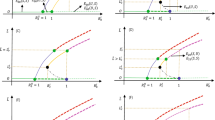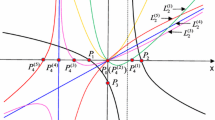Abstract
Releasing Wolbachia-infected male mosquitoes into the wild to sterilize wild female mosquitoes is a bio-safe and effective strategy to block the transmission of the dengue virus. Since the spread of the dengue virus is often subject to some randomness, stochastic differential equations can be used to describe the transmission difference of dengue affected by environmental changes. Considering the latent period of virus transmission, we established a delay stochastic differential system model based on the release of Wolbachia-infected males, which has received relatively little attention. By constructing suitable Lyapunov functions, we obtain sufficient conditions for the extinction of the dengue virus and the existence of a unique stationary distribution. To study the efficacy of the releases Wolbachia-infected males, we find two threshold values \(r_{1}^{*}\) and \(r_{2}^{*}\) of the release ratio \(r\), where \(r_{1}^{*} > r_{2}^{*}\). If \(r > r_{1}^{*}\), then the dengue virus is extinct. If \(r < r_{2}^{*}\), a unique stationary distribution exists, which indicates that the virus is transmitted between humans and mosquitoes. We present some numerical examples to illustrate the impact of environmental noise on the virus dynamics, and we also simulate the dynamics of viruses under different release ratios.







Similar content being viewed by others
Data availability
Data availability is not applicable to this paper as no new data were created or analyzed in this study.
References
Affandi P, Karim M, Suhartono E, Dalle J (2022) Sistematic review: mathematics model epidemiology of dengue fever. Univ J Public Health 10:419–429
Chang K, Zhang Q (2022) Sufficient and necessary conditions of near-optimal controls for diffusion dengue model with Lévy noise. J Math Anal Appl 514:126044
Chen S, Hsieh M (2012) Modeling the transmission dynamics of dengue fever: implications of temperature effects. Sci Total Environ 431:385–391
Cheng Q, Jing Q, Spear R et al (2016) Climate and the timing of imported cases as determinants of the dengue outbreak in Guangzhou, 2014: evidence from a mathematical model. PLoS Negl Trop Dis 10:e0004417
Higham D (2001) An algorithmic introduction to numerical simulation of stochastic differential equations. SIAM Rev 43:525–546
Hoffmann A, Montgomery B, Popovici J et al (2011) Successful establishment of Wolbachia in Aedes populations to suppress dengue transmission. Nature 476:454–457
Hu L, Tang M, Wu Z et al (2019) The threshold infection level for Wolbachia invasion in random environments. J Differ Equ 266:4377–4393
Hu J, Meyer-Baese A, Zhang Q (2022) Analysis of a stochastic reaction-diffusion Alzheimer’s disease system driven by space-time white noise. Appl Math Lett 134:108308
Khana M, Pedersenb M, Zhu M et al (2022) Dengue transmission under future climate and human population changes in mainland China. Appl Math Model 114:785–798
Khasminskii R (1980) Stochastic stability of differential equations, Sijthoff & Noordhoff
Kiouach D, El-Idrissi S, Sabbar Y (2023) A novel mathematical analysis and threshold reinforcement of a stochastic dengue epidemic model with Lévy jumps. https://www.researchgate.net/publication/351744727
Lahrouz A, Omari L, Kiouach D (2011) Global analysis of a deterministic and stochastic nonlinear SIRS epidemic model. Nonlinear Analy-Model 16:59–76
Liu P, Din A (2021) Zenab, Impact of information intervention on stochastic dengue epidemic model. Alex Eng J 60:5725–5739
Liu Q, Jiang D, Shi N et al (2017) Stationary distribution and extinction of a stochastic SEIR epidemic model with standard incidence. Physica A 476:58–69
Liu Q, Jiang D, Hayat T, Alsaedi A (2018) Stationary distribution and extinction of a stochastic dengue epidemic model. J Franklin I(355):8891–8914
Liu Y, Yu J, Li J (2022) A mosquito population suppression model by releasing Wolbachia-infected males. B Math Biol 84:1–32
Mao X (1994) Exponential stability of stochastic differential equations. Marcel Dekker, New York
Mao X (2008) Stochastic Differential Equations and Applications, 2nd edition, Horwood
Ndii M, Adi Y, Djahi B (2022) Deterministic and stochastic dengue epidemic model: exploring the probability of extinction, Barekeng: Jurnal Ilmu Matematika dan Terapan, 16: 583–596.
Otero M, Solari H (2010) Stochastic eco-epidemiological model of dengue disease transmission by Aedes aegypti mosquito. Math Biosci 223:32–46
Sun W, Xue L, Yan X (2018) Stability of a dengue epidemic model with independent stochastic perturbations. J Math Anal Appl 468:998–1017
Tan Y, Cai Y, Sun X et al (2022) A stochastic SICA model for HIV/AIDS transmission. Chaos Soliton Fract 165:112768
Walker T, Johnson P, Moreira L (2011) The wMel Wolbachia strain blocks dengue and invades caged Aedes aegypti populations. Nature 476:450–453
Wang Y, Abdeljawad T, Din A, Taylor T (2022) Modeling the dynamics of stochastic norovirus epidemic model with time delay. Fractals 5:2240150
Yu J (2018) Modeling mosquito population suppression based on delay differential equations. SIAM J Appl Math 78:3168–3187
Yu J (2020) Existence and stability of a unique and exact two periodic orbits for an interactive wild and sterile mosquito model. J Differ Equations 269:10395–10415
Yu J, Li J (2022a) A delay suppression model with sterile mosquitoes release period equal to wild larvae maturation period. J Math Biol 84:1–19
Yu J, Li J (2022b) Discrete-time models for interactive wild and sterile mosquitoes with general time steps. Math Biosci 346:108797
Zheng X, Zhang D, Li Y et al (2019a) Incompatible and sterile insect techniques combined eliminate mosquitoes. Nature 572:56–61
Zheng B, Chen L, Sun Q (2019b) Analyzing the control of dengue by releasing Wolbachia-infected male mosquitoes through a delay differential equation model. Math Biosci Eng 16:5531–5550
Zheng B, Yu J, Li J (2021) Modeling and analysis of the implementation of the Wolbachia incompatible and sterile insect technique for mosquito population suppression. SIAM J Appl Math 81:718–740
Zheng C, Hsu P, Cheng M et al (2022) Predicting infection area of dengue fever for next week through multiple factors. In: International conference on industrial, engineering and other applications of applied intelligent systems, Springer, Cham
Zhu Z, Zheng B, Yu J et al (2022) Stability and periodicity in a mosquito population suppression model composed of two sub-models. Nonlinear Dyn 107:1383–1395
Zou L, Chen J, Feng X, Ruan S (2018) Analysis of a dengue model with vertical transmission and application to the 2014 dengue outbreak in Guangdong province, China, B. Math. Biol. 80: 1–19
Acknowledgements
The research was partly supported by the National Natural Science Foundation of China (12301622, 12331017, 12271116, 11971127), and the Guangdong Basic and Applied Basic Research Foundation, China (2022A1515110436).
Author information
Authors and Affiliations
Corresponding author
Ethics declarations
Conflict of interest
No conflict of interest exists in the submission of this work.
Additional information
Communicated by Huaizhong Zhao.
Publisher's Note
Springer Nature remains neutral with regard to jurisdictional claims in published maps and institutional affiliations.
Rights and permissions
Springer Nature or its licensor (e.g. a society or other partner) holds exclusive rights to this article under a publishing agreement with the author(s) or other rightsholder(s); author self-archiving of the accepted manuscript version of this article is solely governed by the terms of such publishing agreement and applicable law.
About this article
Cite this article
Guo, W., Zheng, B. & Yu, J. Modeling the dengue control dynamics based on a delay stochastic differential system. Comp. Appl. Math. 43, 166 (2024). https://doi.org/10.1007/s40314-024-02674-x
Received:
Revised:
Accepted:
Published:
DOI: https://doi.org/10.1007/s40314-024-02674-x
Keywords
- Stochastic differential equations
- Dengue virus
- Wolbachia-infected mosquitoes
- Delay
- Release ratio
- Stability analysis




